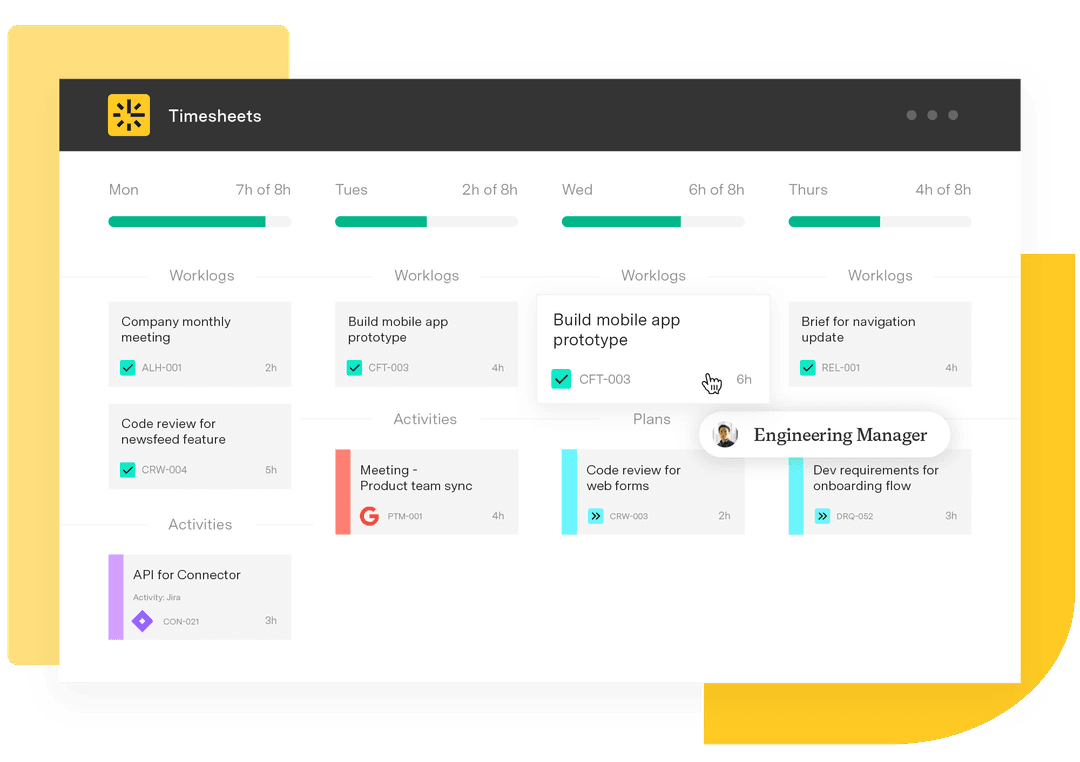Motivation theory: What it is and how to apply it in the workplace
Tempo Team
Motivating a team isn’t always as simple as handing out a bonus. Meaningful motivation goes beyond surface-level rewards – it depends on how people think, what they value, and the conditions in which they work. This deeper analysis is the basis of motivation theory.
Understanding motivation theory helps managers know what drives behavior in the workplace. Whether building a new team or trying to reenergize an existing one, applying the right motivational strategy can boost engagement, enhance collaboration, and improve performance.
In this guide, we’ll define and explore key employee motivation theories and offer practical ways to apply them. You’ll also learn how Tempo’s tools support consistent, motivation-focused management for your team.
What’s motivation theory?
Motivation theory refers to a body of psychological research on why individuals take certain actions and how those actions can be influenced. This umbrella term covers many unique theories on motivation, each providing a framework for understanding what inspires people to perform, persist, and grow.
Motivational theories in business help managers identify the conditions that drive productivity. From psychological needs to perceived rewards, these theories consider a range of internal and external factors that shape motivation. By learning to apply motivating principles, leaders can create work environments that bring out the best in their teams.
6 motivation theories to better understand your team
Different theories of motivation highlight the various elements that influence human behavior. Here are some of the most prevalent theories of motivation in management and how to use them to improve team performance.
1. Maslow’s hierarchy of needs
Maslow organizes human needs into five levels: physiological, safety, social, esteem, and self. People must satisfy lower-level needs before progressing to higher-level aspirations.
How to apply:
Ensure fair pay and safe working conditions, covering physiological and safety needs.
Encourage a sense of belonging through team-building and collaboration, addressing social and esteem needs.
Offer chances for education and growth, giving employees space to satisfy their personal needs.
2. Herzberg’s motivation-hygiene theory
Herzberg distinguishes between hygiene factors (e.g., salary, job security) and motivators (e.g., achievement, recognition). In this theory, both are necessary for satisfaction. Eliminating dissatisfaction isn’t enough; true motivation requires enriching the task itself.
How to apply:
Design roles that offer autonomy, responsibility, and clear advancement paths.
Recognize achievements to reinforce motivators.
Address hygiene factors to maintain baseline satisfaction.
3. Vroom’s expectancy theory
Victor Vroom’s expectancy theory suggests that people’s decision-making processes connect to their expectations about what will happen. People routinely make choices that let them gain pleasure and avoid pain. For example, a team member might avoid a personally frustrating task and complete easier ones instead, even though each one is equally important to the end result.
Vroom’s work acknowledges that people have different values and levels of motivation toward specific outcomes. To account for that, he highlights three key factors:
Instrumentality: Believing that the reward for completing an action will be commensurate with their level of performance or effort
Expectancy: Believing that the reward will be greater if the effort or performance is greater
Valence: Associating an emotion with the rewards
Ultimately, this theory suggests that people find greater motivation when they can predict and influence the outcome of their actions.
How to apply:
Know what your team members value and create opportunities for them to receive those rewards.
Set clear performance expectations by helping team members distinguish between goals and objectives so they know what to aim for and why it matters.
Outline the rewards for increased performance.
4. Reinforcement theory
Based on behavioral psychology, this theory states that consequences are largely what shapes action. Positive reinforcement encourages repetition, while negative outcomes reduce the likelihood of recurrence.
How to apply:
Provide timely recognition or incentives for desirable behaviors.
Avoid unintentionally reinforcing poor habits.
Use consistent feedback to guide employee development.
5. Self-determination theory
This theory emphasizes intrinsic motivation, asserting that individuals are most engaged when their desires for autonomy, self-reliance, and relationships with others are met.
How to apply:
Give employees control over how they complete tasks.
Provide learning opportunities that build confidence.
Encourage peer support and shared responsibility.
6. McClelland’s theory of needs
This theory identifies three key motivators: achievement, affiliation, and power. Everyone is driven by a unique blend of these needs, influencing how they interact and perform.
How to apply:
Give high achievers clear goals and regular feedback.
Offer team projects to those motivated by affiliation.
Provide leadership opportunities to those who seek influence.
These theories of motivation offer a range of strategies to address different team organizations, job roles, and goals. Whichever one you embrace is up to the individual dynamic of your team.
The importance of motivation in the workplace
Understanding what motivation theory is and using it effectively is critical for an engaged workforce. Here are some of the benefits:
Boosted productivity: Motivated employees are more focused and produce higher-quality work.
Lower turnover: People who feel valued and inspired are likelier to stay.
Improved teamwork: Team members collaborate more effectively if motivated to succeed, building stronger dynamics.
Innovation and creativity: Empowered employees are more likely to take the initiative and propose new ideas, primarily when they work in a culture that promotes a positive attitude.
Motivational theories in business aren’t just academic concepts. They provide actionable frameworks that inform leaders and influence real-world outcomes.
Applying motivation theories in the workplace
Integrating theories of motivation in management doesn’t require a complete overhaul of your organization. Here are a few ways to apply motivational theories in the workplace:
Design incentive programs based on Herzberg or Vroom
Use Herzberg’s model to build intrinsic motivators into role design.
Apply Vroom’s principles to ensure reward systems are as fair and achievable as possible.
Create opportunities for autonomy aligned with self-determination
Let employees choose how they approach tasks or participate in setting goals.
Promote self-directed learning and cross-functional collaboration.
Use recognition strategies inspired by Maslow’s higher-level needs
Acknowledge achievements publicly to address social needs.
Connect recognition with personal growth or long-term contribution.
Provide consistent feedback
Recognize desired behaviors as they happen.
Use one-on-one meetings and coaching sessions to guide behavior.
Leverage tools like Tempo’s Dashboards
Make progress visible so team members see how their work contributes to larger goals, motivating them to succeed.
Use data insights to recognize and reward effort.
Applying these strategies aligns individual motivations with organizational goals. It also cultivates a work environment where people feel seen, supported, and inspired to do their best. If you’re new to motivation theory, try these tips for new team leaders to get started.
Supporting motivation and engagement with Tempo
Theories of motivation offer powerful insights, but they must be consistently applied and supported with the right tools to be effective. Tempo’s suite of Jira-native solutions enables managers to put these motivational principles into practice by giving stakeholders the clarity, accountability, and structure they need to stay engaged.
Timesheets helps you track team effort and recognize contributions in real time, reinforcing a strong link between performance and reward. With Custom Charts, teams can visualize their progress and understand how individual work supports broader goals. And Financial Manager provides account visibility that matches compensation and incentives directly with outcomes.
By promoting transparency, enabling feedback, and supporting better planning, Tempo helps managers create a highly motivated workplace environment.













































